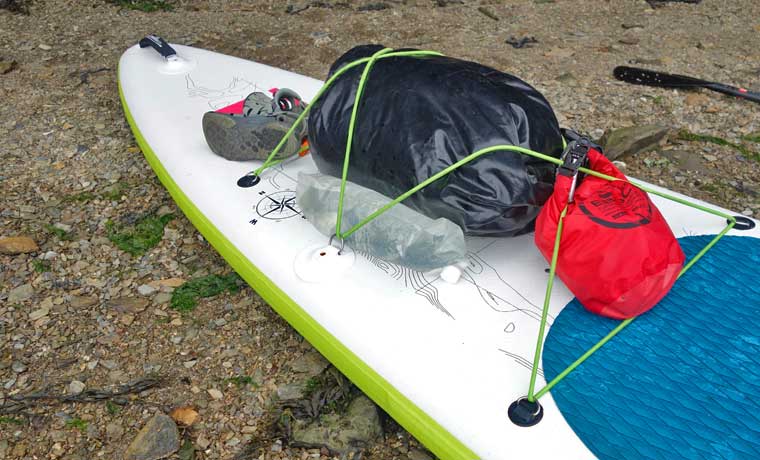It was inevitable that, with the rise of stand up paddle boarding in recent years, SUPs would start to be used as transportation vessels for adventures further afield. What could be better than taking to the water with everything you need for a multi-day adventure safely packed onto your very own floating platform?! Very little, in my opinion. Which is probably why paddle board camping, also known as SUP camping or paddle board touring, is also on the rise.
I’ve done a load of canoe camping over the years. And I love it. So I was delighted to get the opportunity to transfer all my knowledge of how to pack a canoe, what to wear and what to take for an overnight trip, and apply it to paddle board camping. I was also VERY interested to see how SUP camping compares to good old-fashioned canoe camping.
In this article you’ll find information on the logistics of paddle board camping and how to go about it if you’ve never done it before. Plus I’ll try to share everything I’ve learned from my recent multi day SUP trips.
- Basic paddle board camping tips
- What type of SUP is best for paddle board touring
- What to pack for a SUP camping trip
- How to choose a campsite for SUP camping
- How to load your SUP for paddle board touring
- More SUP camping tips and a few lessons learned
Basic paddle board camping tips
01Start small
Though it might be tempting to go on a huge mission for your first SUP camping trip, it’s a good idea to start small. You’ll learn so much on your first trip that you can then apply to longer and bigger future trips. But many of your lessons will be learned from mistakes or mishaps which have greater consequences the more remote you are, or the more paddling you need to do. So, unless your first paddle board touring expedition is guided or with someone who has experience, start small.
Start with a two day trip on a lake, sheltered bay, estuary or slow moving river, and camp out for one night. Ideally limit the miles to under 5 each day, depending on the tides, wind, water flow, and your experience.
02Check the weather
There are certain types of bad weather that just dampen your mood and may make your time less enjoyable. And then there’s the type of bad weather that can make your trip mega challenging and potentially dangerous. So before you head out into the eye of a mahoosive oncoming storm, be sure to check what weather you are likely to encounter and what is on its way.
Windy conditions can make life either really difficult, or really easy, depending on which direction you are paddling! But high winds can also be very dangerous on open seas, especially if conditions change. It’s also not a good idea to be on the water if there’s the potential for electrical storms.
Equally, if the weather is looking peachy, don’t assume that’s what you’ll get! Conditions can change very quickly in coastal or mountainous areas. So as as well as your sun protection, it’s always a good idea to expect the worst and understand what you might have to face if things change.
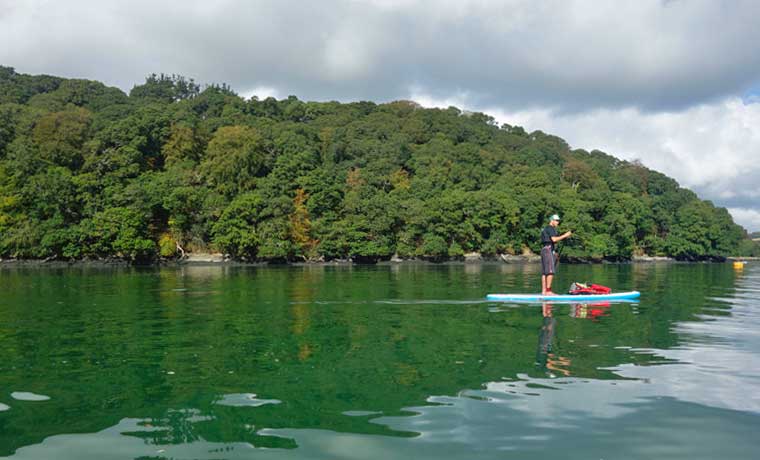
03Understand the water
Most first time SUP campers won’t be new to spending time on the water. If paddle boarding is totally new to you, however, then spend some time paddling on different bodies of water before you head out on a multi-day SUP trip. Read our paddle boarding guide for more information.
Even if you have lots of experience on the water, it’s still important to plan your trip around the conditions that you will face. This is especially important if you plan on paddling in a tidal estuary. Plan your get in and out points around the tides, and if necessary, visit the launch areas before you commit to them. Don’t forget that spring tides have a much greater tidal range than neap tides, so factor this in, too. Also, try to work with the tides when on your journey. Paddling with the tidal flow will make life much easier, and more enjoyable.
If you are planning to paddle on a river, you should keep a close eye on the rainfall preceding the trip. But also look at the forecast for the area upstream of where you intend to paddle. This will help determine whether the river is likely to rise significantly whilst you are paddling which may affect the suitability of the river in question. It will also help when choosing a riverside location to camp. More on that later.
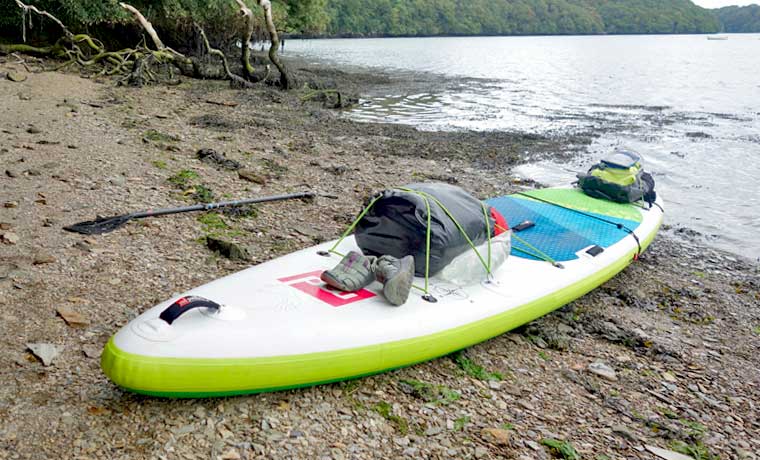
04Pack light
There’s a fine line between packing minimally and being ill-prepared. And although less gear that is lightweight will certainly make your paddle board easier to manage, I’m always a proponent of sacrificing speed for the sake of comfort and safety. What’s the rush, anyway?
Pack like you’ve got to carry all your equipment on your back. See our backpacking packing list for more information on this including extra layers in case you fall in on your first mile!
05Know your board
Ideally, your first paddle boarding camping trip will be on a board you are familiar with. You should know how to inflate and deflate it, how to repair it, how to carry it and how to paddle it. But you should also be familiar with what gear attachment points are available so that packing and loading isn’t a drama in itself!
If you’re paddling on a rented or borrowed board then be sure to take it for a spin before you load it up with gear. This will help you understand exactly how long the fin is when launching, how responsive the board is to paddle and also how sensitive the board is when standing on it.
06Have a plan B
If you have planned your trip well then it will probably go exactly as you hoped with no hiccups along the way. However, it’s a really sensible idea to have a contingency plan if things do go awry. A member of your party could develop a strain and be unable to paddle anymore. Or a SUP could become damaged and no longer seaworthy. These are by no means catastrophic incidents, but without a plan B things could turn sour more quickly than you may think.
Be sure to know some alternative access points to get off the water. Know where the nearest settlement is, and how best to get there. And also have a backup phone charger that is reserved for emergencies only. If you are close to civilisation (which is a good idea on your first trip), be sure to take some cash with you and the number of a taxi company.
Finally, you should always register your trip with someone responsible who knows exactly what your plan is. This downloadable float plan can be used as a good guide.
What type of SUP is best for paddle board touring
Paddle board touring can be done on any stand up paddle board. However, choosing a board that is specific to touring will make it much more enjoyable.
Some features of touring SUPs:
- Wide
Wide paddle boards tend to be more stable, which is especially important when the board is loaded with gear. - Long
Longer boards move more easily through flat water and thus move more quickly. If you are paddling long distances a fast moving board is super important. - High volume
High volume boards float more easily than low volume boards. This helps when negotiating choppy conditions, but is also important when carrying gear on your board. - Attachment points
Touring paddle boards should have multiple gear attachment points both at the front and back of the board to distribute the gear evenly and securely. - Inflatable
Inflatable paddle boards, or iSUPs, perform well as touring boards due to their relatively lightweight nature and portability.
Another thing to consider is whether the fin is flexible or not. If you plan on paddling in low water or on shallow rivers then a flexible fin is a good option to avoid damage without having to remove the fin altogether.
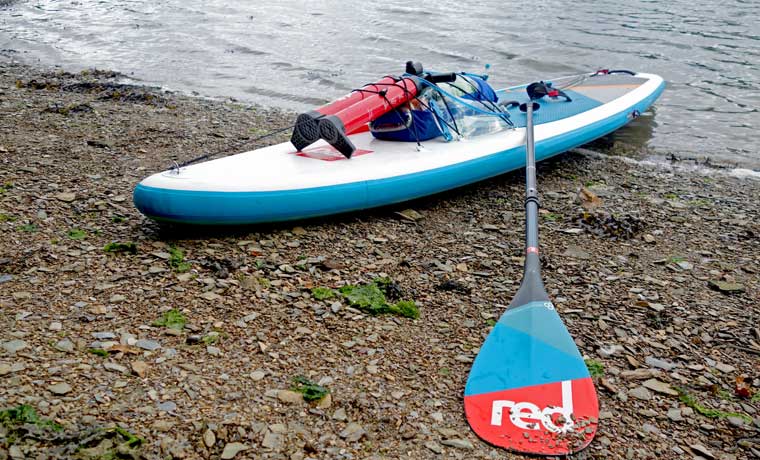
What to pack for a SUP camping trip
There’s no set way to pack for a SUP camping trip, and of course everyone has different things they like to take. The list below is what I like to take and is a good guide for you to build upon to suit you.
Click the ‘x’ to delete items off the list that you know you don’t need. Then click the box next to all the other items once you’ve packed them.
Alternatively, we’ve put together a printable SUP camping checklist PDF to tick and cross with a good old-fashioned pencil! You can also add your own items to this.
Large dry bag:
Ideally, there should be nothing in the dry bag that you need during the day. It will only be opened when you set up camp in the evening.
Sleeping stuff
Spare clothes
Personal items
Medium dry bag
If you have one dry bag that you don’t fully rely on for its waterproof capabilities then use it here. Again, this bag doesn’t really need to be accessed during the day, unless you plan on having a hot drink or soup at lunchtime. If so, then be sure to pack the items you may need at the top of the bag for easy access.
Cooking equipment and food
Safety gear and other items
Small dry bag:
This bag should be easy to access throughout the day whilst you are on the water. It should include things that you will need most often.
Easy access items
Other items
These are items that don’t need to be stored in a dry bag, but they do need to be securely attached to the board or to a dry bag.
SUP camping checklist PDF
If you want to make life as easy for yourself as possible, print out the below paddle board camping PDF. Handily, it has space to write in extras that aren’t already on the list and you can easily share it with your hiking buddies to guide them through what to take bike touring.
Download SUP Camping Gear ChecklistDry bags for paddle board touring
As described above, you will need at least three dry bags. If you have more than three then you’ll have more flexibility on what you pack into each one. But you also need to consider what attachment points are available on your paddle board and work around them. There’s no use having 5 small dry bags if you’ve got nothing to attach them to.
Also, there are certain items that I like to store in a small dry bag and then pack into a bigger one. Like my sleeping bag and my insulated jacket. At least then, if everything else gets wet in a worst case scenario, you still have something dry and warm to get into. If you don’t have a small dry bag, use a large zip lock bag, or even two heavy duty plastic bags.
Another thing to consider is whether your dry bags have external attachment points. If your board is lacking places to attach gear (shoes, water etc) then see if you can attach them to your dry bags instead.

Food for SUP camping
Though keeping things as lightweight as possible is important, you don’t need to go super lightweight when it comes to food. One pot meals are always a good option as they are easy to cook on a single stove or over a fire. I like to bring lots of fresh veggies and cook up a stew or a pasta dish. Tinned tomatoes or jars of pesto work well too. It’s a good idea to pack fresh food into its own bag within a larger dry bag.
For more ideas check out these one pot camping recipes, my favourite halloumi and pepper camping stew and these campfire desserts.
Some people like to snack throughout the day instead of having a proper lunch. That comes down to personal preference. But for some lunch and snack ideas read our backpacking food article.
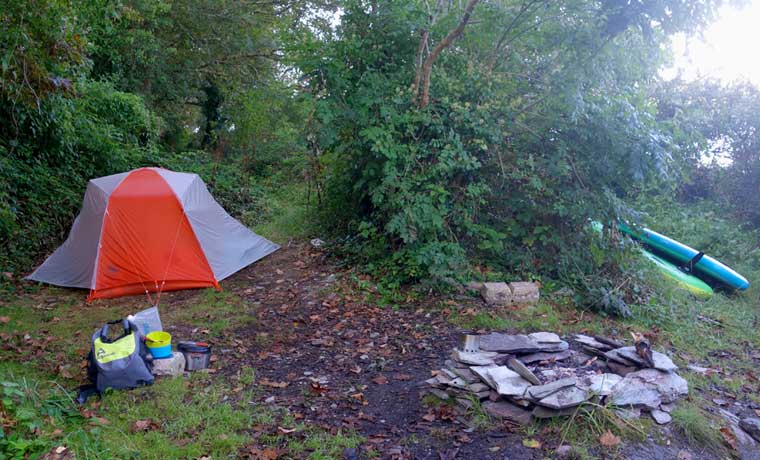
Tent, hammock or bivvy bag when SUP camping
Your choice of camping accommodation largely comes down to personal preference, but also where you are likely to be camping and the weather.
Bivvying is often a good option if you are likely to be sleeping on a beach as it’s more discreet than a tent and also doesn’t rely on finding places to stake a tent down to. Couple it with a tarp in case of bad weather and you’ve got a pretty great shelter. You can use your SUP paddle as a pole for the tarp and even prop up your board on its side to form extra shelter at ground level.
For more information read our tarp camping article and our guide to bivvying.
Hammock camping is a superb choice if you are exploring forested shorelines or riversides. You don’t need to worry about beaches being tidal or finding a flat enough spot to pitch a tent. Plus, if you’re feeling adventurous, you can set up your hammock over the water!
Read our guide to hammock camping to get a better idea whether this might work for you, or not.
Tents offer the greatest level of protection from bad weather and bugs, and are an excellent option if you know there is likely to be flat ground available to pitch on. However, unless you have a lightweight backpacking tent, most tents are bulky to pack and are heavy. That said, they can be easily split so that each member of your group carries a part each. And if poles are too long to fit in a dry bag then they can be secured on the outside of a bag. Just be sure that they are secured very well!
Read our guide to backpacking tents to understand what sort of size and weight tents are available.
Drinking water for paddle board touring
If you know there will be fresh water available that you can filter, then you’ll only need to take a couple of litres with you. I like to take a water bladder that can be tucked under the bungee cords on the SUP and easily sipped from when sitting or kneeling down on the board.
If collecting water is likely to be an issue then you’ll need to take it all with you. Again, bladders, collapsible flasks or soft containers work well for this as they are easy to store on the board and even easier to carry once empty.
If you have a fancy buoyancy aid then it may even have pockets big enough to carry a water bladder or small bottle.
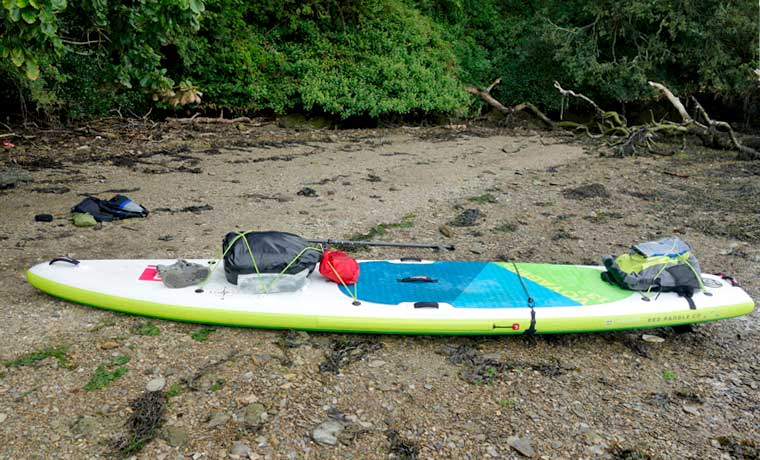
How to load your SUP for paddle board touring
You’ve got all your gear packed into dry bags, and you know exactly what’s in every dry bag, right? Now you need to load up your SUP. It’s essential that you do a practice pack and load at home so that you can customise things if you need to. Have some extra bungee cords and carabiners at the ready!
Generally speaking, a SUP should be loaded like a canoe: with the weight balanced more or less equally between the front and back, with a little less weight at the front. All the heavy things should be placed over the centre line of the board to prevent the board from leaning to one side.
Once you’re on the water with all your gear packed onto your board, be sure to assess the trim (how it is positioned in the water) of the board before you set off. If there is too much weight at one end then you’ll need to move things around until the load is more evenly distributed.
The more you go paddle board camping, the more you’ll figure out what works for you, and what doesn’t.
How to choose a campsite for SUP camping
Choosing an appropriate place to camp when paddle board touring is much like choosing a place to camp when backpacking.
Ideally, your camping spot should be:
- Discreet – not seen by houses or settlements
- Not on private land
- Not in a narrow river valley
- Close to drinking water, if possible
- On flat, dry land
- Sheltered
- Positioned facing a great view!
For more information about wild camping read our article on how to camp at the beach, and also get some ideas from our stealth camping guide!
Other things to consider when SUP camping
The nature of paddle board camping means that you will almost always end up camping close to water, which can bring a few challenges with it.
Bugs!
Depending on the location and the time of year, bugs can be a real issue when camping near the water. Getting a fire going, if appropriate, will help fend off bugs, to a degree. But you may also need to bring bug nets, repellent and citronella candles. Adjust the above packing list accordingly.
Tides
Is the area you are camping in tidal? If so then you’ll need to be very sure of the high tide line if you are considering camping on a beach. As mentioned above, you will also need to know whether the next incoming tide is a spring or neap tide.
Dams
If you are touring on a lake and hoping to camp on its edge then check whether the lake is dammed or not before you head off. I’ve made the mistake of camping on a lake beach only to find out – when I felt water lapping at my feet in the middle of the night – that the lake was dammed! I had no idea. And I certainly didn’t realise that the water level would rise that much in such a short period of time, despite the lack of rain. It’s a mistake you’ll only make once! I had to abandon camp at 4am, pack up and paddle on.
Wildlife
One of the best parts about SUP camping is the ability to get to really wild places where wildlife flourishes. This provides an excellent opportunity to get closer to the natives from the calm and quiet of the water. However, it’s a good idea to do a little bit of research before you go about what you might encounter. Some places are restricted or protected at certain times of the year for breeding etc.
Additionally, those beautifully tranquil beaches that would be ideal for camping on may also be favoured by larger beasties who come down to the water to feed and drink! So check the area for obvious animals trails or tracks before you settle in for the night.
Leave No Trace
As with all types of camping and outdoor activities, it’s imperative that you follow the Leave No Trace Principles when SUP camping. In fact, cruising untouched waters provides the perfect opportunity to do some litter picking as you paddle. So why not bring a spare bag along to fill up with any trash you might come across?
For a reminder of the Leave No Trace Principles, take our quiz.
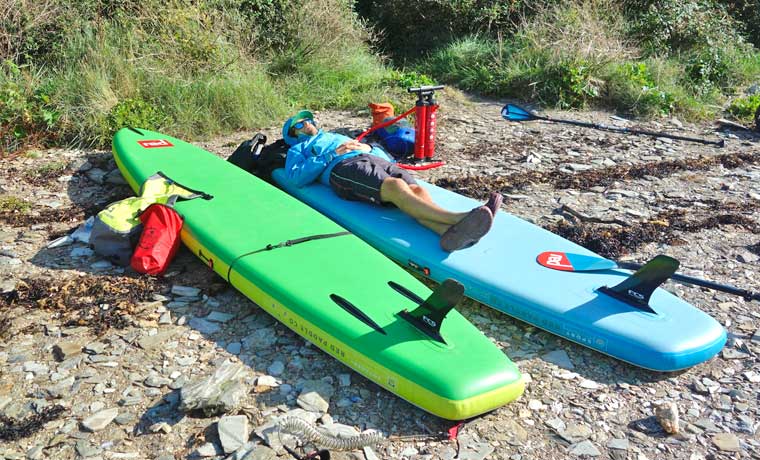
More SUP camping tips and a few lessons learned
Here are a few other small tidbits of information that may be of value to those new to the world of paddle board camping:
- A propped up SUP makes an excellent windbreak for cooking behind
- Taking a snooze on a SUP (on dry land) is more comfortable than it looks!
- You don’t need to bring anything to sit on at camp – your SUP will be quite sufficient
- Don’t forget your pump
- Always pack a repair kit, and know how to use it
- Practise a self-rescue with gear on board
- Don’t underestimate how much harder/easier the wind makes paddling
- Alternate between standing, kneeling and sitting if paddling is becoming tiring
Thanks to Red Paddle Company for supplying us with inflatable touring paddle boards for our trips this summer.
For more information read my full review of the Red Paddle Co Voyager 13.2 Paddle Board.




